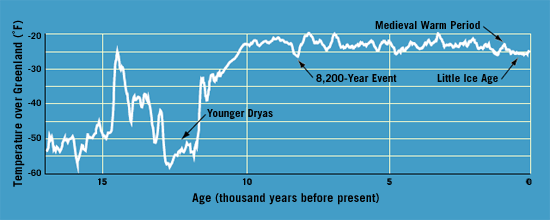Paul, that 'orbital' graphic you asked about came from:
Cabrillo.edu/Ruddiman http://www.cabrillo.edu/~rnolthenius/climate/Denialists/D-Ruddiman/index.html
...
but to your main point:
...it looks like your picking up on a few of the things
I have been saying and I can agree with almost all of
your post , except this part
We are now drastically over-compensating
(in red color, below) for the natural global cooling
because we are
not compensating enough and
this is shown
in the below image.

If you lived in Vostok,
in East Antarctica, then you might worry about global cooling,
because that graph above (
colored, pink/magenta line) is for Vostok temperatures.
And as predicted, East Antarctica is cooling ...during the initial stages of a global warming event. But as a long-term proxy for global
temperature ranges and temperature changes, it is a very handy, albeit rough estimate.
The main point was to illustrate how temperatures are
not following the Milankovitch forcing anymore; and while Vostok might show a cooling 'trend' over thousands of years, the Vostok temperatures are still fairly ‘flat’ compared to what you’d expect, based upon past behavior.
And do you think the most recent century shows up on those huge ice-core records? You’ve seen plenty of high-resolution charts for the past 10,000 years, and the past 1 to 2 thousand years, which show an even more (relatively) ‘flat’ or level slope/trend for global temperatures, such as:

...a magnified view of (
a different version of) that last quarter inch you're talking about.
===
But if you can see how this mechanism,
in which slowly increasing levels of GHGs
offset the Milankovitch cooling trend
...to produce a relatively level temperature trend;
can you also see how a large pulse of GHGs would upset that balance?
===
And, if a large pulse of GHGs rapidly initiated this current interglacial,
by raising temperatures by about 10 °F,
then why wouldn’t a similar pulse of GHGs cause a similar rise in temperatures
...as the ensuing decades permit adjustments?
...especially since any cooling cycles will end soon enough,
and go on returning to their average;
while the GHGs accumulate, persist, and continue to add more heating force.
~



 ...a magnified view of (
...a magnified view of (
